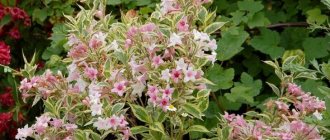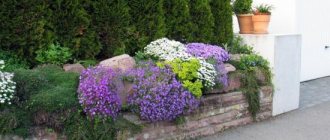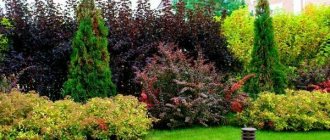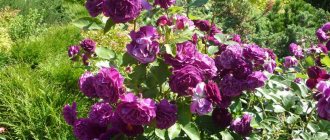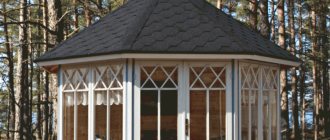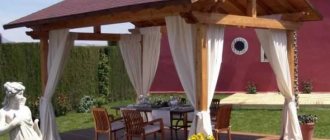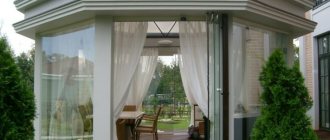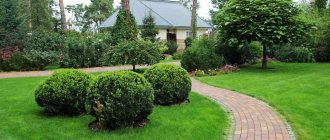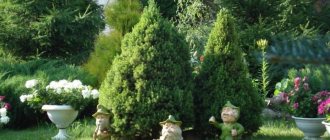A country house is not only about furnishing the interior of a room, but also about a variety of plants and decorative elements that decorate the area. Many owners of summer cottages prefer to decorate the yard with their own hands and rarely resort to the help of landscape design specialists, solving the issues of gardening their own plot. Let's consider what to plant along the fence.
Categories of flowers that can be planted near the house
Almost all flowers that are planted in flower beds are sun-loving.
Accordingly, it is necessary to choose an area where there is constant sunlight and there are no strong winds. Therefore, it is not worth planting flowers somewhere on a hill. Look for secluded places for this. The best option would be areas near the gazebo or some buildings. Clubs are often planted near hedges, fences and fences. All plants can be divided into two categories:
- Perennial
- Annuals
If you don’t want to deal with choosing new crops for your flowerbed every year, and don’t know what flowers to plant near your house, give preference to perennials. Experienced gardeners prefer to combine a riot of flowers and colors. For this purpose, both annual and perennial plants are chosen.
Plantings Plantings
Plantings Plantings
Planting flowers next to the fence
Regardless of which side of the fence you plan to plant the plants on, the flowers will look original here. They not only attract attention and are pleasing to the eye, but can also become a hedge, hiding possible defects or design flaws. If the hedge is new, then flowers, on the contrary, will attract attention to it. They can be planted in one or several rows.
Planting shrubs of different sizes along the fence Source pinterest.ru
One- and perennial plants are suitable for these purposes. Annuals will have to be planted every year. In summer they need watering and feeding. Therefore, if there is no time for this, then it is better to choose suitable perennials. The most popular were peonies or roses. But in order for them to have an attractive appearance, they also need to be periodically watered, pruned, and fertilized. If not properly cared for, they will occupy a large area and will look unattractive.
Experienced gardeners often plant rudbeckias, sunflowers and hollyhocks: they are quite unpretentious in care and are not picky about the soil.
Coniferous plants near the fence of the site Source acacia.od.ua
Types of flower beds for planting near the house
There are several varieties of club, depending on the plants used and the shape.
Types of flower beds for planting near the house:
- The most popular are mixborders, these are flower beds of mixed plants, usually along paths or hedges. They can have any shape, and allow you to fantasize on an unlimited scale.
- Modular flower beds. They are a kind of mixture of small architectural forms and the colors themselves. In fact, this is not exactly a flowerbed, but a whole composition. It may include some kind of base made of ceramic, plastic or stone, decorated with flowers. Below you can see photos of such clubs.
- Tapeworm. This is a flower bed that has common characteristics among all growing flowers. This could be their shape, height or overall color.
- Club curb. In this option, the flowers are planted close to each other and do not require a lot of light. Typically, such flower beds are used as a separate decorative element for the design of more voluminous compositions in order to limit their limits. This is the dividing strip between the lawn and the flower arrangement. Dense flowers with small buds are used, which are planted around the perimeter of the main flower arrangement.
- Stone garden . This is a flowerbed that combines stones and flowering plants. Usually this is a separate composition, which consists of zones made of a mound of large stones, or expanded clay, as well as flowers. Very often, such flower beds are supplemented with small shrubs.
- Rock garden. Such flower beds usually combine plants that grow in alpine conditions.
Composition Composition Composition Composition Composition
Beautiful decoration of a flower bed near the house with your own hands: instructions, photos
At the beginning of the work, a plan is constructed and plants are selected. To do this, an initial assessment of the soil and plant growing conditions is carried out. The experience of the gardener is also important. Therefore, if you are arranging a flowerbed for the first time, choose unpretentious plants that can survive in rather specific weather conditions, with a lack of moisture and care.
Beautiful decoration of a flower bed near the house with your own hands, instructions:
- If you don’t have time to dig in the garden, choose plants that require certain climatic conditions, but are completely unpretentious in care. They do not require regular weeding, pruning, or fertilizing. At the initial stage, in early spring, it is necessary to dig up the soil to a depth of approximately 25 cm.
- This will saturate it with oxygen and improve plant growth. Next, you need to remove all the weeds. If there is lawn grass growing on the site, you are planning to create a flower bed, you need to remove the layer of grass and dig up the area.
- Remember that all plants grow best in light soil. Therefore, if the soil on the site is too heavy or clayey, supplement it with sand and be sure to add compost. You can use organic and inorganic fertilizers. However, organic matter such as chicken manure or compost has proven to work best. Acidic soil needs to be diluted with ash.
- If the soil is too light, add a small amount of clay soil or stone flour. It is necessary to draw a plan of the flowerbed on paper and deal with the plants. Tall plants are planted in the center of the flowerbed, followed by a layer of plants with a lower height, and everything goes down. This way you will get a kind of slide. If you plant all the plants in a free order, without taking into account their height, some may not have enough space or light.
- After all, taller plants will shade them. Be sure to consider the position of the sun in the early morning. It is necessary that the plants are exposed to sunlight most of the time. Below you can use one of the flowerbed construction schemes.
Composition Composition
Composition Composition Composition Composition
Landscape Design Rules
Most of the area in a dacha or personal plot is occupied by a garden and a vegetable garden. But there isn’t much space left for a flowerbed. Usually this is a small area near the house and a place along the fence. To make the space along the fence look impressive and beautiful, you need knowledge about the principles of design of flower beds and flower beds.
First, it is important to decide how many meters you can allocate for a flower bed along the fence. If the fence is long and the plot of land there is wide enough, then the choice of plants is unlimited. But when there is little space at the dacha, every meter is taken into account, then flowers and shrubs are selected in small sizes.
It is necessary to plant plants that have the same requirements for soil, watering, and sunlight. When choosing seedlings, take into account which side the fence is located on (in the sun or in the shade).
There are many types of fencing for the area along which plants are planted: from picket fence, wood (boards), chain-link mesh, corrugated board, brick or slate. The choice when planting green spaces is also influenced by the height of the fence, the heating properties of the material, etc.
When plants are planted in the southern part of the site, the choice is made of drought-resistant crops that require a large amount of sunlight for full development. The soil here will need to be watered much more often. Therefore, in such a flowerbed there is no place for flowers that require abundant watering.
In the northern part of the farmstead, cold-resistant plants are planted that are not afraid of strong winds. You can plant a hosta near the fence or build an alpine hill with coniferous crops, for example, fern and horizontal juniper.
What flowers should I plant near my house?
Unpretentious plants include geranium, poppies, gentian, goldenrod, musk . Please note that there is no need to replant them, they grow in any conditions and do not require constant watering.
What flowers to plant near the house:
- There is another group whose plants are considered moderately whimsical. There is no particular need to care for them, but sometimes they need to be replanted. Transplantation of such perennial flowers is carried out every 3 years. They do not grow well in one place for a long period of time. Among them are cornflower, sage, cloves, iris, and echinacea.
- To fill in the area near the trees, bulbous plants are often planted. They are quite unpretentious, but they need to be planted not in spring, but in autumn. Planting usually takes place from late September to early November.
- This time is necessary for the plant to take root. Remember that bulbous plants are an ideal option for complementing an area near trees, as they do not have a developed root system and will not interfere with the trees by entwining their roots. It is necessary to choose plants with different flowering periods. blooms first , then the daffodils and tulips , and lastly the allium .
Hedge Hedge Hedge
Features of creating mixborders along the fence
Mixborders are compositions of flowers and shrubs planted in one place. Such flower beds need to be created in such a way that they are at least 1.5 m wide, but not more than 4 m. Flowers are planted in small groups, so that the tall ones are in the background and the shorter ones are in front. Shrubs are planted in tiers.
What to plant near the fence at the dacha to create a beautiful composition? The peculiarity of creating mixborders is that they bloom continuously. The following combination of plants will look good:
- bulbous flowers are planted in the foreground: tulips, daffodils. They begin to bloom from early spring until May;
- Flowers are planted in the middle, for example, lilies of different varieties. They bloom in May-July;
- Tall perennials such as cannas can be planted in the area in front of the fence. This is a shrub that blooms profusely and has beautiful glossy leaves;
- A small lawn is planted in front of the flowerbed. It is separated from the main composition by some kind of decor. This allows you to create a complete composition that will look especially beautiful from a distant angle.
The main thing when growing shrubs is to take into account their branching. It is better to give preference to plants that do not grow much, so that they do not block their neighbors. In the case of a double-sided mixborder, the highest point of the flowerbed should be in the middle. From it, various trees and shrubs are distributed in different directions in decreasing height.
Is it possible to plant a linden tree near the house?
Linden is an excellent choice for planting near the house. It absorbs carbon dioxide and releases large amounts of oxygen. The tree is considered a mother and has received a lot of attention since ancient times. Almost all kitchen utensils were made from linden, because its wood is easy to process, but at the same time very durable, does not rot, does not chip, crack or shrink.
Is it possible to plant a linden tree near the house:
- If you want to plant a tree near your house, consider the location. The plant tolerates drought well, but cannot tolerate flooding. If there is a pond near the house, you should not plant a linden tree.
- It is believed that the linden tree is a symbol of femininity and happiness; it is capable of making wishes come true. That is why linden is an ideal option for planting near the house. Early in the morning you can ask her for women's happiness, marriage or a child.
- The tree is easy to care for and fills the entire area with aroma. Try not to plant a tree directly next to the house, but retreat a little. This is due to the fact that a large amount of liquid flows to the foundation, or what flows from the roof gets into the soil. This will provoke shadow, rotting, and dampness in the place where the linden plant is planted, which is unacceptable for it.
Linden
Shrubs
Bushes near a private fence made of corrugated board or chain-link mesh also look beautiful. They are unpretentious in maintenance and are able to close off the territory of a private house from prying eyes.
If the area is sunny, then you can plant lilacs on it. It will bloom in spring and summer; it is better to cover lilac bushes in autumn and winter. Amur lilac is a hardy bush variety.
Lilac
Barberry will make the plot unusual, and you can pick red berries from it in summer and autumn. This plant loves both sun and shade. The main thing in caring for barberry is watering, especially during the fruiting period. This is a medium-height bush with long branches and requires planting 2 m from a private fence.
Barberry
Hydrangea bushes will decorate a private chain-link fence. Hydrangea blooms in red and other colors and tolerates any neighborhood. After planting in a flower garden near a fence, bushes can grow tall in the fall and are capable of blocking the area from prying eyes.
Hydrangea
Is it possible to plant a pine tree near the house?
Many residents of private houses dream of planting a pine or spruce tree near their cozy nest. This will bring joy in the winter, and will allow you not to buy a forest beauty for the New Year holidays, but to dress it up in the yard. There are several negative signs associated with spruce.
Is it possible to plant a pine tree near the house:
- The Slavs believed that a tree is a sign of the deceased; it prophesies death. During the times of Kievan Rus, coffins were made from spruce, and the path to the cemetery was covered with spruce branches. This is where the sign that spruce brings death comes from.
- It is believed that such plants repel males. If the family that planted such a tree is quite strong, the marriage may soon collapse. In the yard where such a tree grows, sons are not born, but only daughters.
- However, all these are prejudices; landscape designers skillfully use coniferous trees to create beautiful compositions. If you are a superstitious person, give preference to Canadian pine, or Smereka.
- After all, in Western Ukraine this tree is considered special, and it has no connection with the other world and death. It is believed that it brings comfort to the home and helps improve family relationships. Now it has become fashionable to grow fir, because there are no signs associated with it.
It is worth remembering that almost all coniferous trees have a developed root system, so they must be planted at a distance of at least 10 m from any buildings. If there is a gazebo, fence, or house on the site, it is necessary for a coniferous tree to grow between them. A strong root system during growth can destroy foundations, fences and other buildings. The tree dries out the soil, and it is not worth planting anything at a distance of 5-6 m from conifers.
Pine
What shrub should I plant near the house?
Derain is one of the best shrubs; even with small amounts of starting material, many bushes are obtained, because they are planted by division. The main advantage is that in the fall such a shrub turns bright scarlet or burgundy, which decorates the summer cottage.
What shrub to plant near the house:
- viburnum leaf , meadowsweet or spirea near houses This shrub begins to bloom from the end of June, and in autumn the leaves turn red or yellow.
- It is best to plant plants in a sunny place, this directly affects the color of the leaves of the bush. Please note that these shrubs grow very quickly, so they will need to be divided and replanted from time to time.
- Lawn grass is often sown in front of the flowerbed, separating it from the flowers with decorative elements. These could be stones or some kind of wooden structures. Please note that when planting shrubs, you need to focus on their branching.
- If the bushes produce a large crown, then it is best not to plant light-loving plants next to each other, as there will be shadow in this place. If you live in northern latitudes, then it is best to plant shady plants that are frost-resistant near the fence. The best option is Siberian fir and rowan . You can plant hydrangea .
Shrubs Shrubs Shrubs Shrubs
Top 5 best plants
To answer the question of which shrubs to plant along the fence, let’s look at the brief characteristics of the most popular ones that do not require systematic care and are drought-resistant.
White dogwood is an unpretentious plant
The shrub is widespread and popular; it is grown in the middle zone, the Urals and Siberia. Derain is able to survive cold winters without shelter, and is relatively resistant to high summer temperatures and short-term droughts.
The shrub is not demanding on air quality; it is planted along roads and used for landscaping cities.
The maximum height of the bushes is within 2 m. Flowering occurs in the summer months; in the fall, the branches are decorated with inedible white fruits. The turf is decorated with variegated foliage. The simplicity of cutting allows even gardeners who do not have extensive experience in this matter to form beautiful bushes.
Low-growing conifers can be used as a companion when planting turf.
Spiraea, or Viburnum-leaved Bladderwort
The correct selection of varieties will allow you to create a hedge that blooms throughout the summer.
The height of the bush is about one and a half meters; active growth and tillering allows it to quickly form dense thickets along the fence. Specimens that grow freely look no less attractive; they bloom more abundantly.
What low-growing shrubs can be planted near the house?
If there is very little space near the house, this does not mean that you need to give up shrubs. Choose dwarf plants. Japanese quince is suitable for this It blooms with crimson flowers for a long period of time in the spring and produces fruits with beautiful bright spots. You can decorate the area near the house with dwarf lilacs . Small bushes bloom beautifully and do not grow too quickly. Of course, the larger the plot, the greater the opportunity for imagination, but not everyone can boast of this.
What low-growing shrubs can be planted near the house:
- When choosing a shrub, it is necessary to evaluate the soil. Sandy soil is quite acidic, dry, and has very few nutrients. , hydrangea and sea buckthorn grow well Some shrubs grow quickly in wet gardens.
- Among them it is worth highlighting chokeberry, spirea and wild rosemary. If the soil is clayey and very dense, then almost all types of ornamental shrubs will be an ideal option. Be sure to keep in mind that perennial shrubs can grow up to 6 m.
- Magnolia can spread its crown about 5 m wide and grow up to 6 m. Accordingly, it should not be planted near a fence, as this can damage the fence and also cause discontent among neighbors. Choose the most compact varieties that do not spread out the crown too much. Columnar juniper will do . Be sure to take into account some of the characteristics of the bushes and the possibilities of their growth.
Low-growing bushes Low-growing bushes Low-growing bushes Low-growing bushes
How to choose the right plant?
Landscaping serves several functions:
- plants are able to free the atmosphere from harmful substances;
- trees produce oxygen;
- ornamental plants make the estate more beautiful.
When deciding what will decorate the line along the fence, you need to consider the following points:
- the side of the world on which the plants will be planted;
- Is this place blown by the wind?
- what is the area of the site that is planned to be landscaped;
- why plants are planted (zoning of a site, decorative function of a fence, creating shade);
- site planning;
- height of the proposed planting;
- design and material from which the fence is made;
- groundwater depth;
- soil features;
- varieties of plants (whimsical or unpretentious);
- growth rate of the selected plant;
- compatibility of cultures.
Hedge of non-standard shape Source promaster77.ru
Important! If the area is small, flowers or low shrubs will look better along its fence. In a large open area, massive trees would be appropriate.
Low-growing plants should be planted by the side of the road. They will be able to absorb harmful substances and trap dust. A beautiful green wall can be created if the plantings are made dense and planted closely.
Plants that grow near the fence on the yard side Source dizainexpert.ru
If the selected plant has a massive root that can grow quickly, then it should be planted away from the fence (at a distance of 3-5 m). This will protect the base of the fence from cracks and destruction by a powerful root.
In order for the site to always look attractive, when choosing options for its landscaping, you need to give preference to crops that will bloom at different times. It is also worth considering the compatibility of plants.
Green spaces along the fence Source mrrestavrator.ru
Tall unpretentious flowers along the fence: list
If you choose a shrub, then try to plant domestic plants near it that tolerate the local climate well. Give preference to sunny areas or places where there is partial shade. Be sure to cut off the buds after flowering.
Tall unpretentious flowers along the fence, list:
- Garden jasmine has proven itself well . It grows up to 3 m, the main feature is thin branches that are covered with leaves. They differ in their color from green to golden. During flowering they release a pleasant jasmine scent.
- Park roses have proven themselves well ; they look very beautiful when blooming. These are unpretentious plants; even novice amateur gardeners can plant them. The ideal growing location is loamy soil and good lighting. It is necessary that there is a distance of 1.5 m between the bushes. The main principle of care is regular watering. Almost no additional fertilizer is needed.
- Rhododendron. A very beautiful crop that blooms from mid-April. The flowers are large, double and pink and lilac in color. During flowering, green leaves are practically invisible. Ideal for central Russia, and are frost-resistant. Choose shaded areas that are away from drafts.
- Lilac is a shrub found near almost all private houses because it gives beautiful color and aroma. It is unpretentious and frost-resistant. Depending on the type of lilac, its height and crown differ.
Fencing Fencing Fencing Fencing
About the height of bushes
When choosing, it is recommended to pay attention to their characteristics, in particular the dimensions, including height.
For clarity, let's make a table.
| Dimensions of bushes | Plant name |
| Low-growing, up to 50 cm high | Boxwood, gooseberry, cinquefoil, alpine currant, yellow acacia |
| Medium height, height up to 3 m | White dogwood, thuja, rose hips, hydrangea, weigela, heather varieties, juniper, lilac |
| Tall, exceeding 3 m | Yew, hornbeam, hawthorn, dogwood, western thuja |
To obtain a more attractive picture, it is recommended to plant the bushes in two lines, the first may consist of low-growing ones, the second - of taller ones. Of course, this option is acceptable for large areas.
What to plant near the gazebo?
To improve the area near the house, it is not necessary to purchase expensive carved gazebos made of natural wood. Plants can transform a gazebo beyond recognition. Among the flowering plants that climb and can completely entwine a gazebo, it is worth highlighting honeysuckle, clematis, and roses.
What to plant near the gazebo:
- You can plant perennial plants that climb. Among them it is worth highlighting grapes, hops and wood pliers . When choosing plants, adhere to the following rules.
- Tall plants are planted directly next to the walls of the gazebo, near the structure. As soon as the plants grow in size, they need to be staked or supported. This will allow them to grow upward and entwine the walls of the structure.
- Medium-sized plants are planted after tall or climbing ones. At the very bottom you can plant low-growing flowers. The gazebo can be decorated with pots of flowers that are hung inside. Clematis grow well near the gazebo . You can plant honeysuckle as it climbs and can produce vines up to 5 m high.
Alcove
Gazebo Gazebo Gazebo
What flowers can be planted along the fence?
Flowers are planted along the fence in flowerbeds or plots. Can be planted pointwise. Dahlias or anemones are considered one of the most beautiful . They are tall enough, so they can hide the imperfections of the fence. You can plant decorative forms of dahlias , but this must be done after preliminary germination of the tubers. 3 weeks before planting, the bulbs are placed in a regular pot and watered. This allows the plants to grow stronger and not be afraid of climate change and cold weather.
What flowers can be planted along the fence:
- is used to decorate the fence . This is a tall plant that can reach a height of 120 cm. The flowers are quite large, and are often planted on a stem. Mallow is planted by sowing in May. Please note that the plant blooms only a year after planting. Before sowing, the seeds are soaked for 12 hours in warm water. This speeds up their growth.
- Near the fence, flower beds called mixborders have proven themselves to be excellent. These are compositions of flowers and shrubs that are planted along the hedge. They must be at least one and a half meters wide. You should not plant them along the entire perimeter of the fence.
- They are located in small groups. In this case, tall crops are planted near the fence, and low-growing ones in front. Tulips, daffodils or any bulbous plants are usually planted in the foreground Keep in mind that they bloom from April to May. Lilies are planted in the middle and bloom from May to July. Moreover, their height is slightly greater than that of daffodils and tulips. Immediately in front of the fence, perennial flowers are planted, which have different heights.
Hedge Hedge Hedge
What do they plant near fences?
As a rule, the height of a corrugated fence allows you to hide the life of its owners from prying eyes, which is why you should not choose tall plants for a hedge. Let's consider the best decor options.
Shrubs
Gardeners love to decorate fences with shrubs, which perfectly camouflage an inconspicuous hedge. They are easy to care for, do not weave around the fence and do not grow in any direction. Derain is very popular. Its bright color in combination with conifers allows you to create an unusual composition.
It will look great next to the fence - barberry-Tumberga. These low spherical bushes look spectacular in the autumn due to their red-yellow color. However, do not forget that barberry does not like darkness and cold wind. The best place for it will be the south side of the fence. But you don’t have to worry about watering - the moisture received after the rain is enough for it.
Pay attention to shrubs such as lilac, chokeberry, and hawthorn. Such bushes grow quickly, covering the iron fence.
Choosing trees
Almost every summer resident is accustomed to planting trees along the fence, creating a certain barrier to the site. Here you can find not only fruit trees, but also chestnuts, birches, and lindens. The most traditional tree for decorating a farmstead is needles. To make the composition original, small spruce trees are planted at a distance of 35 cm from each other, and their development is constantly monitored.
What flowers should I plant near the fence in the shade?
Near the fences, it is best to plant tall, climbing plants that can cover some of the shortcomings of the fence. This is an excellent option if the fence was installed many years ago and there are some errors in its structure.
What flowers to plant near the fence in the shade:
- Among the most popular options are bougainvillea . The plant is native to South America and is distinguished by very unusual flowers with bright colors. Please note that it loves warmth and a lot of light. That is why it is necessary to plant in places with sunny side. It is worth watering the plant from time to time and under no circumstances use nitrogenous fertilizers. Regularly cut off young shoots and fertilize them with mineral components after 2 weeks.
- Wisteria is a very beautiful perennial plant with unusual inflorescences. It is worth remembering that the plant is quite demanding, so the ideal option for planting is a warm, sunny climate. There are breeding variations that tolerate frost well. One of them is the Blue Moon variety.
- Baljuan knotweed . Quite a powerful plant that grows quickly. This is a perennial; vines can grow up to 5 m in one season. They are distinguished by clusters of fragrant flowers, which are collected in inflorescences. They bloom until late autumn. The plant is unpretentious, and even pests avoid it.
- Maiden's grapes . This is a crop with beautiful leaves that turn bright red in autumn. It is not afraid of cold weather and produces poisonous berries of a dark purple color. If a small child lives in the house, refuse to plant this plant so that the child does not accidentally eat the berries. Feels very good in the shade, and even in poor soil.
- Honeysuckle . This is an unpretentious plant that should be planted near the fence. It is distinguished by unusual tubular-shaped flowers and bright orange berries. Lianas grow up to 6 m in length in one season. They cover the hedge with a dense carpet, without gaps.
In the shadow
In the shadows In the shadows In the shadows
What can be planted near the fence on the street side?
Flowers are often planted along the fence not only from the side of the house, but also from the street. This will additionally help protect the house from intruders. The ideal option for protection is rose hips, which are planted on the street side. It is unpretentious and produces beautiful flowers. Another great option would be a golden ball - rudbeckia. It produces bright yellow flowers, which is why it got its second name. The height reaches 3 m, blooms from July to late autumn.
What can be planted near the fence on the street side:
- Bright euonymus . This is an excellent option for planting from the outside, as it has unusual fruits. The main advantage is its unpretentiousness, but requires planting in a shady place. To form the crown, annual pruning is necessary.
- Perennial lupine . It is a lush plant with beautiful flowers. It blooms in the second year after planting. It is characterized by rapid growth and a fairly long flowering period. It is best to plant if the fence is solid. This is due to the fact that the plant reproduces quickly, so it can easily enter your area if there is a hole in the fence. The plant loves partial shade.
- Snow-white vangutta . This is a shrub with unusual cascades of flowers, which are often called snow or bride. It blooms in the first half of summer, but sometimes repeats flowering in autumn. Loves the sun, so shade is unacceptable.
Plants
Plants Plants Plants Plants
Many useful articles can be found on our website:
- The most interesting plants in the world - strange, poisonous, beautiful, rare, dangerous: description, photo
- Magical herbs and plants: list, methods of use in magic
- Why is it not recommended to water plants with cold water?
- Rare plants of the Red Book of Russia and the world with names, descriptions and photographs
- What plants, flowers, trees and shrubs bloom in early spring before the leaves bloom: names, list, photos
Initially, the basis of the composition is made up of perennial plants; gaps are made between them, allowing annuals to be planted every year, which can significantly change the appearance of the flowerbed, its filling and color.
Purpose of flower beds along the fence
From a design point of view, flower beds and flower beds along the fence represent multi-purpose and diverse structures. When decorating this piece of land on the site with your own hands, do not be afraid to show your imagination and implement your ideas. Even when the landscaping work seems costly. Everything will pay off in beauty! Create compositions from stone or other available materials - today it looks stylish and beautiful. A planned design will help:
- disguise an unaesthetic hedge along the fence;
- use plants to hide from the prying eyes of neighbors looking out for what is happening on your territory;
- continue the process of zoning the local area;
- please the eye and add beauty to everyday life;
- transform strips of soil along the demarcation line into stylish flower and shrub plantings;
- create a complete image and a unified composition of all available space on the site;
- create a soft, effective transition from the house to the boring fence;
- and simply save soil for garden crops by creating a flower bed under the fence.
